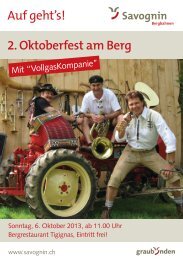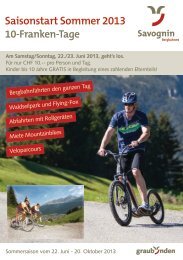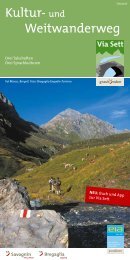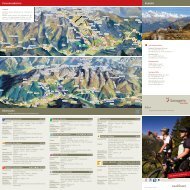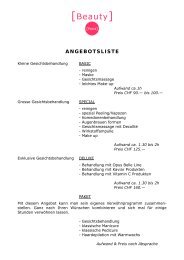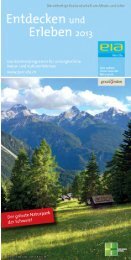Spassegio cultural tras vischnanca - Savognin
Spassegio cultural tras vischnanca - Savognin
Spassegio cultural tras vischnanca - Savognin
Create successful ePaper yourself
Turn your PDF publications into a flip-book with our unique Google optimized e-Paper software.
Nr. 2: The traffic<br />
The traffic<br />
All over the valley remains of old roads which bear witness to the<br />
fact that the two mountain passes Julier and Septimer were used<br />
in ancient times already can be observed. Coins and lead bullets<br />
with punched legion numbers found on the Septimer Pass, prove<br />
that roman soldiers used the pass.<br />
In the years 1816/1817 a big famine devastated the area and<br />
due to the bad road connections to the neighboring countries,<br />
especially to Italy, it was impossible to import enough foods. The<br />
government of Grisons reacted and under the lead of the engineer<br />
Richard La Nicca the road from Chur over the Julier Pass was<br />
further developed in the years 1820-1840. With the beginning<br />
of the tourism in the Upper Engadin in the middle of the 19th<br />
century the traffic over the Julier Pass increased substantially. In the<br />
year 1847 696 passengers were traveling by stage coach through<br />
our valley, in the year 1858 the number increased to 1‘332.<br />
In 1860, when the European nobility travelled to St. Moritz or<br />
Bormio for treatments at health resorts the number even reached<br />
5‘340 passengers. The stage coach started out in Chur at 6 o‘clock<br />
in the morning and reached St. Moritz at 8 o‘clock in the evening.<br />
The journey was tiring for passengers and horses. The horses were<br />
changed in Churwalden, Tiefencastel, Mulegns and Silvaplana.<br />
Mulegns had a big significance at the time, explaining why the<br />
Posthotel Löwen could be built to offer accommodation and meals<br />
to the travelers. In summer there were up to 100 horses put up in<br />
large stables. There was also a blacksmith, as well as a saddlery.<br />
It‘s remarkable that the once so proud post office in Mulegns was<br />
closed as the first one of the valley on 28th february 1994.<br />
In 1903 the railway line over the Albula from Chur to Celerina was<br />
established. With the new, faster and more comfortable connection<br />
to the Engadin the stage coaches lost their significance, which<br />
also meant the loss of work and income for many inhabitants<br />
of the valley. It was only after 9 negative popular votes that the<br />
automobile traffic was finally allowed in Grisons in the year 1925.<br />
The postal car could operate earlier already, due to a decision of<br />
the federal council, in the areas, where there was a need for it. In<br />
our valley the first postal car drove to Mulegns in summer 1920,<br />
to Bivio in 1922 and in over the Julier Pass to St. Moritz in summer<br />
1923. That same summer 26‘000 passengers used the service.<br />
Gelgia / Julia<br />
Veia Tgampi<br />
Stradung<br />
Veia Sandeilas<br />
Before the development of the Julier road there existed two roads<br />
through the village which can be seen from this location: the<br />
lower road (7) and the upper road (8). The two merged again at<br />
the hotel Piz Mitgel (9). The road through the village was renovated<br />
and developed one last time in 1977 and various buildings<br />
had to be torn down. A bypass around the village was dismissed<br />
at the time.<br />
Veia Davos Tga<br />
The stately Peterelli residence (1) from the 15th century got its<br />
final shape in the middle of the 18th century. On the inside there<br />
are many rooms with valuable furniture and paintings. Remarkable<br />
is the entrance door with a carving of a double-headed<br />
eagle, the family crest of the Peterelli family above the entrance,<br />
as well as the beautiful fence with the emblem of Grisons between<br />
two ibexes.<br />
From this house and family originates many an important personality<br />
such as different officers serving foreign powers and politicians.<br />
Colonel Johann Anton Peterelli received the title of nobility<br />
from empress Maria Theresia and council man Remigius Peterelli<br />
represented the canton of Grisons in Switzerland‘s capital Berne.<br />
The residence is privately owned these days. Directly adjoined is<br />
the Caminada residence (2), also an influential ministerial family,<br />
which has died out in the meantime. Remarkable are also the<br />
two houses behind us (3+4) with pictures of the Virgin Mary, the<br />
church Son Mitgel (5), consecrated in the year 1663, as well as<br />
the harmonious group of houses (6) from the 17th century behind<br />
the Guetg residence.<br />
The «Via Sett», a long distance hiking trail which connects Thusis<br />
to Chiavenna, exists since 2011. The trail is marked with the<br />
number 64 and leads through a unique alpine landscape. In five<br />
days of hiking you can discover three valleys with three different<br />
language areas (german, romansh and italian).<br />
– 54 – – 55 –<br />
1<br />
5<br />
2<br />
8<br />
3<br />
4<br />
6<br />
7<br />
Veia Canete<br />
Veia Strada<br />
9<br />
lottas



